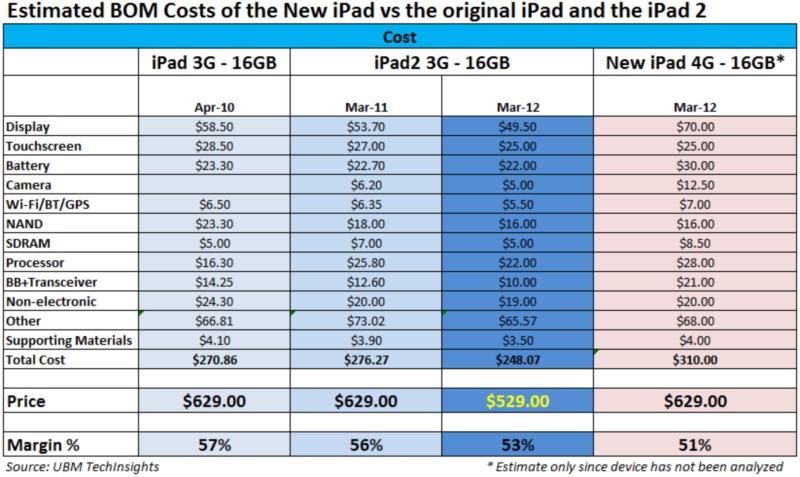New iPad 4G 16GB Costs an Estimated $310 in Parts
Despite the addition of 4G LTE, a new Retina display, and quad-core graphics, Apple's latest iPad carries the same launch price as the iPad 2 and the original iPad. But how much does it cost Apple to produce? According to preliminary analysis from UBM TechInsights, the components for Apple's newest iPad carry an estimated cost of $310. Now, we all know that cost of parts aren't everything, especially when you throw in production costs, R&D, marketing, and all of the other costs associated with designing, producing, and shipping a product. However, this is interesting in that, if accurate, it means Apple isn't making as much with the iPad 3 as it did with the iPad 2 or the iPad 1.
According to the following table from UBM TechInsights, the cost of parts for the original 16GB iPad was $270.86 with a profit margin of 57 percent). Things crept up just a little for the iPad 2. UBM prices the components for the 16GB iPad 2 at $276.27 for March 2011, which represents a difference of 1 percent (56 percent) in the profit margin. However, for iPad 3, which boasts a more expensive display, battery, camera and processor, the cost of parts is estimated to be $310. With a retail price of $629, this represents a profit margin of just 51 percent. Still a lot, but quite a dip from the 57 and 56 percent margins of the iPads 1 an 2. Additionally, Apple is losing a little more on the iPad 2 with a drop in price pushing the retail price of the iPad 2 down to $529.
"The bottom line is the new iPad’s margin should take a little hit because of some expensive adders like LTE, the high-res display and camera, a bigger battery and faster processor,” Jeff Brown, a senior UBM TechInsights analyst, is quoted as saying by the EETimes. Apple “will hope to offset that margin decrease with a slightly higher margin on the iPad 2,” he said.
We'll have a better idea of where things stand once the iPad is officially available and we can get some more precise figures. However, with the insane demand Apple has seen for the new iPad, we can't imagine Apple being too preoccupied with a 5 percent drop in profit margin.
Follow @JaneMcEntegart on Twitter!
Get Tom's Hardware's best news and in-depth reviews, straight to your inbox.

Jane McEntegart is a writer, editor, and marketing communications professional with 17 years of experience in the technology industry. She has written about a wide range of technology topics, including smartphones, tablets, and game consoles. Her articles have been published in Tom's Guide, Tom's Hardware, MobileSyrup, and Edge Up.
-
kawininjazx A profit of JUST 51%? That's not too bad considering a lot of other electronics manufacturers. Heck, we just had that article where Acer said they were breaking even with their entry level ultrabook.Reply -
LuckyDucky7 In other news, luxury technology that has few actual uses still costs a lot of money.Reply -
siman0 They will pay even if apple put apple 4000GSTX Type 2 on an old apple 2 and then anounce it as the god giving wonder device. Its from apple people follow that band waggonReply -
drwho1 On other news Apple's R&D has been working on their very own Apple Pie which according to "sources"Reply
will regenerate itself as you bite on it.
/sarcasm -
applerocks magaapple,apple,apple,apple....,again its everywhere ,just STOP it i had enough OK .Reply
No we will be back tomorrow to hold the gun to your head and force you to read Apple news! -
MKBL When a giant company like Apple orders its product to be produced in a facility at likes of FoxConn, it dictates how much margins the manufacturers would get. Apple also has a lot stronger buying power than regular high-tech companies, so their component prices are more likely to be cheaper than for others. Apple can control its profit margin by controlling those two fronts, parts and manufacturing, without much exposure to the usual risks of manufacturing and part sourcing.Reply -
elkein magaapple,apple,apple,apple....,again its everywhere ,just STOP it i had enough OK .Wakey Wakey, the world is passing you by. I love my homebuilt machine, I advocate and tech support other people. But at work I'm tearing out numerous PC terminals, because iPads are replacing them. When one gets eaten by a vat of acid, no big deal, have another, there's a stack of backups.Reply -
zzz_b I do not understand where they loose on the iPad 2.Reply
The price is still $399 and the parts are less than $277. They make less profit, but do not loose anything. Also, iPad 3 being out, the iPad 2 is becoming obselete.

